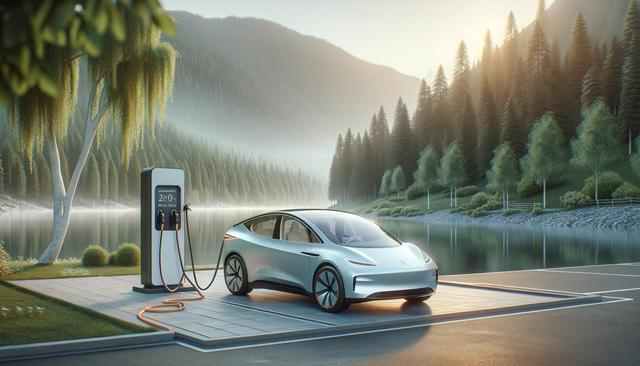What Defines an Electric Car?
Electric cars, often referred to as EVs (electric vehicles), are powered entirely or partially by electricity, rather than internal combustion engines that rely on fossil fuels. There are three main types of electric vehicles: Battery Electric Vehicles (BEVs), Plug-in Hybrid Electric Vehicles (PHEVs), and Hybrid Electric Vehicles (HEVs). BEVs operate solely on electric power, while PHEVs and HEVs combine electric motors with traditional fuel engines to offer greater flexibility. These vehicles use electric motors powered by rechargeable battery packs, which can be charged via home outlets or specialized charging stations. The rise of EVs is not just a trend; it’s a shift toward a cleaner, more sustainable form of transportation.
Some distinguishing features of electric cars include:
- Regenerative braking systems that convert kinetic energy into stored battery power
- Minimal noise and vibration during operation
- Lower maintenance requirements due to fewer moving parts
- Instant torque delivery for quicker acceleration
As technological advancements continue to improve battery efficiency and charging infrastructure, electric cars are becoming more practical for everyday use.
Environmental Benefits of Electric Vehicles
One of the most compelling reasons for the growing popularity of electric vehicles is their positive environmental impact. Traditional gas-powered cars emit large amounts of carbon dioxide and other pollutants, contributing to climate change and urban air pollution. In contrast, electric vehicles produce zero tailpipe emissions when running on battery power alone, offering a cleaner alternative for urban and rural environments alike.
Additional environmental advantages include:
- Reduced greenhouse gas emissions
- Lower dependency on fossil fuels
- Improved air quality, especially in densely populated areas
- Potential for renewable energy integration through solar or wind-powered charging
While the production of EV batteries does require significant energy and resources, studies show that the overall carbon footprint of electric cars is still substantially lower over the vehicle’s lifetime compared to conventional cars. Efforts are also underway to develop more sustainable battery production and recycling methods, further minimizing the environmental impact.
Charging Infrastructure and Range Considerations
One of the primary concerns among potential electric vehicle owners is the availability of charging infrastructure and vehicle range. Fortunately, significant investments are being made globally to expand public and private charging networks. Charging stations are becoming more common in urban areas, parking structures, and along major highways, making long-distance travel increasingly feasible for EV owners.
Electric vehicles typically offer three levels of charging:
- Level 1: Standard home outlets, suitable for overnight charging
- Level 2: Higher voltage home or public chargers that reduce charging time
- Level 3: DC fast chargers, ideal for quick top-ups during travel
Vehicle range varies depending on the model, battery size, and driving conditions. Most new electric cars can travel between 150 to over 300 miles on a single charge. While that may still be less than the range of gasoline vehicles, continued improvements in battery technology are steadily narrowing the gap. Additionally, real-time navigation systems in many EVs help drivers locate nearby charging stations, alleviating range anxiety.
Economic Factors and Ownership Costs
Though electric cars often have a higher upfront cost compared to traditional vehicles, they offer considerable savings over time. Lower fuel costs, reduced maintenance, and various government incentives make EVs a financially sound choice for many drivers. Electricity is generally cheaper than gasoline, and EVs are more energy-efficient, meaning owners spend less per mile driven.
Key economic benefits include:
- Tax credits and rebates in many regions for EV purchases
- Lower maintenance expenses due to fewer mechanical components
- Reduced fuel costs with home or public charging options
- Longer vehicle lifespan with fewer emissions-related issues
As the market for electric cars grows and competition increases, prices are gradually becoming more accessible. Leasing options and certified pre-owned EVs are also making it easier for consumers to make the switch without a heavy financial burden.
Future Outlook and Technological Advancements
The future of electric cars is closely tied to advancements in technology and changes in consumer behavior. Automakers are investing heavily in EV research and development, focusing on enhancing battery life, reducing charging time, and integrating smart features. Autonomous driving technology, vehicle-to-grid (V2G) systems, and improved connectivity are some of the innovations set to reshape the driving experience.
Emerging trends to watch include:
- Solid-state batteries offering higher energy density and faster charging
- Wider availability of wireless charging systems
- Integration with renewable energy sources for cleaner charging
- Expansion of EV options across vehicle types, including trucks and SUVs
Consumer demand, combined with supportive government policies and environmental targets, is expected to accelerate the adoption of electric vehicles in the coming years. The shift is not just about transportation; it’s part of a broader move toward sustainable living and energy efficiency.
Conclusion: Embracing the Electric Evolution
Electric cars represent a major step forward in creating a more sustainable and efficient transportation system. Whether motivated by environmental concerns, economic advantages, or interest in cutting-edge technology, more drivers are considering EVs as a viable alternative to traditional vehicles. As infrastructure improves and innovation continues, electric vehicles are poised to play a leading role in shaping the future of mobility. For individuals, families, and businesses alike, now is a compelling time to explore the potential of going electric.




Leave a Reply